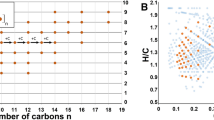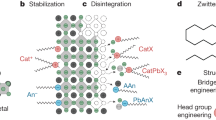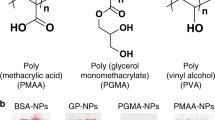Abstract
The tailoring of inorganic minerals such as iron oxides for functional use in biological systems for iron storage1, structural support2 and magnetoreception3 involves biological regulation of crystal structure, particle size, morphology and crystallographic organization. The encapsulation of crystallochemical reactions within enclosed biological microvolumes enables control to be exerted over: (1) the chemical regulation, by passive or facilitated ion-transport, of localised supersaturation levels (2) the stereochemical requirements for ion-binding, redox and nucleation events at the organic matrix interface and (3) the spatial organization of crystal growth and morphology4,5. Matrix-mediated growth of inorganic materials has not been systematically investigated in vitro even though it may have applications in crystal engineering and materials science6. We have used phospholipid unilamellar vesicles of ∼300 Å diameter to study membrane-mediated processes of iron oxide crystal growth. Intravesicular deposits differ in structure, morphology and size from precipitates formed from reactions in bulk aqueous solution. Mediating factors include vesicle shape and dimension, diffusion-limited processes of ion-transport and ion-binding at the curved lipid headgroup surface. These results help elucidate biomineralization and have technological relevance to the controlled synthesis of monodisperse sols with catalytic and magnetic properties.
This is a preview of subscription content, access via your institution
Access options
Subscribe to this journal
Receive 51 print issues and online access
$199.00 per year
only $3.90 per issue
Buy this article
- Purchase on Springer Link
- Instant access to full article PDF
Prices may be subject to local taxes which are calculated during checkout
Similar content being viewed by others
References
Ford, G. C. et al. Phil. Trans. R. Soc. 304, 551–565 (1984).
Mann, S., Perry, C. C., Webb, J. & Williams, R. J. P. Proc. R. Soc. B227, 179–190 (1986).
Mann, S., Frankel, R. B. & Blakemore, R. P. Nature 310, 405–407 (1984).
Mann, S. Struct. Bond. 54, 127–174 (1983).
Mann, S. J. inorg. Biochem. (in the press).
Birchall, J. D. Trans. Br. Ceram. Soc. 83, 158–165 (1984).
Mann, S., Kime, M. J., Ratcliffe, R. G. B. & Williams, R. J. P. JCS Dalton Trans. 771–774 (1983).
Mann, S. & Williams, R. J. P. JCS Dalton. Trans. 311–316 (1983).
Stumm, W. & Morgan, J. Aquatic Chemistry (Wiley, New York, 1984).
Author information
Authors and Affiliations
Rights and permissions
About this article
Cite this article
Mann, S., Hannington, J. & Williams, R. Phospholipid vesicles as a model system for biomineralization. Nature 324, 565–567 (1986). https://doi.org/10.1038/324565a0
Received:
Accepted:
Issue Date:
DOI: https://doi.org/10.1038/324565a0
This article is cited by
-
Nanoreactors for particle synthesis
Nature Reviews Materials (2022)
-
Ferritin RNA interference inhibits the formation of iron granules in the trophocytes of worker honey bees (Apis mellifera)
Scientific Reports (2019)
-
Ca-Mediated Electroformation of Cell-Sized Lipid Vesicles
Scientific Reports (2015)
-
Nanostructure, solvation dynamics, and nanotemplating of plasmonically active SERS substrate in reverse vesicles
Journal of Nanoparticle Research (2013)
-
Synthesis and characterization of polyethylenimine-based iron oxide composites as novel contrast agents for MRI
Magnetic Resonance Materials in Physics, Biology and Medicine (2009)
Comments
By submitting a comment you agree to abide by our Terms and Community Guidelines. If you find something abusive or that does not comply with our terms or guidelines please flag it as inappropriate.



